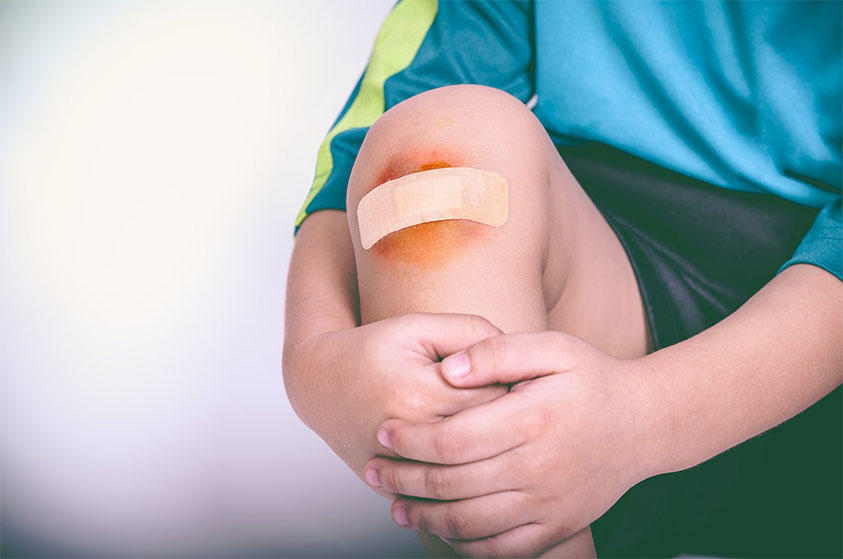
Children have a knack for getting sick or sore. From sporting accidents to asthma attacks, most schools see as many injuries and illnesses as a busy emergency room.
Teachers are often the first people on the scene when these potentially life-threatening accidents happen. That being the case, formal first aid training and education is essential for all school teachers, childcare workers, and anyone who works with children. The following 5 introductory schoolyard first aid tips will help teachers keep their students happy and healthy at school.
1. How to respond when a student is bleeding
Bloodshed is not uncommon in the schoolyard. Whether tending to a grazed knee or a deeper cut, teachers should be equipped with a well-stocked, good-quality first aid kit. A variety of bandages and Band-Aids should be on hand so that, no matter what kind of injury, the teacher can swiftly and effectively dress the wound. When a student is suffering from significant blood loss, apply pressure to the wound and raise it to slow or stop the bleeding, before calling for an ambulance.
2. How to respond when a student is choking
Choking incidents are common among young children. No matter how many times you tell them to chew their food carefully, the advice tends to fall on deaf ears. When a student starts to choke, encourage them to cough out whatever is blocking their airways. If they can’t cough it out, give up to five sharp back blows between their shoulder blades, to slap out the offending food. In some cases, you may need to give up to five abdominal thrusts, in order to squeeze it out. Having a valid CPR certification can help teachers respond more confidently in these emergency situations. If these techniques fail, call for an ambulance.
3. How to respond if a student is unconscious
Open the child’s airway, tilt their head and check for breathing. If they seem to be breathing, put them in a recovery position. If they are not breathing, call triple zero to ensure that an ambulance is on the scene as soon as possible.
When breathing stops, it’s usually an indication that the heart will need some encouragement. Begin CPR using the CPR kit from your first aid supplies. To get the heart pumping again, give the victim 30 chest compressions at a rate of between 100-120 per minute. Pumping to the beat of Staying Alive is a nifty tip to ensure that you maintain the correct pace. After 30 chest compressions, give the victim two rescue breaths. Continue alternating between pumping and rescue breaths until the paramedics arrive.
If you do not know how to perform CPR, check the CPR card in your first aid kit to ensure that you use the correct technique. Be prepared, take an online BLS Course on basic safety. In situations where a young child requires CPR, refer to this Infant CPR fact sheet.
4. How to respond when a student breaks or fractures a bone
If the child presents with an open fracture, cover the wound with a sterile dressing and secure it with a bandage from the first aid kit. Apply pressure around the wound to control any bleeding and support the injured limb or body part to minimize movement. Once you’ve done this, call triple zero for medical help. Unless the patient is in immediate danger, don’t move them. Even the slightest movement could potentially exacerbate the severity of the fracture.
5. How to respond when a student has an asthma attack
It’s important that teachers know which students are predisposed to asthma. Asthma outbursts are usually accompanied by the following symptoms: wheezing, coughing, chest tightness, and shortness of breath. A mild asthma attack can escalate quite suddenly, resulting in severe shortness of breath and bluish lips. If the student is conscious, help them into a comfortable sitting position and give them 4 puffs of an asthma inhaler, administered one at a time with 4 breaths after each puff. Repeat after four minutes if symptoms persist. If the child is still struggling for breath, call emergency services and report an asthma attack. Repeat inhaler treatment until the paramedics arrive.
These tips should not be used as a substitute for formal first aid training. When you work with young people, your quick-thinking, well-informed, first aid smarts could be the difference between life and death for a vulnerable student in an emergency situation.
In addition to seeking out professional training, ensure that your school is equipped with a well-stocked compliant first aid kit. When accidents happen, it’s imperative to have the right supplies and the right know-how to treat your injured students.
Author Bio:
Sara is the marketing strategist of Survival Emergency Solutions, Australia’s leading provider of first aid products for the home, workplace, vehicle and outdoors. Their Emergency First Aid Handbook is the only book to win the Australian Design Award and has sold over 2 million copies.


























